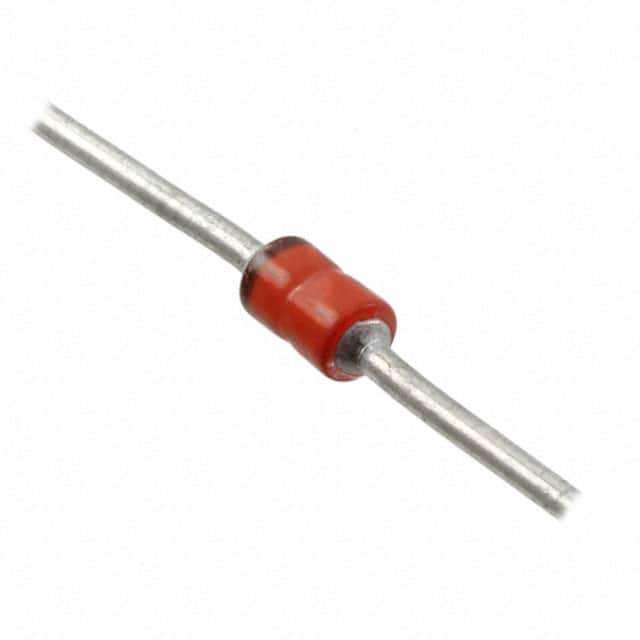Viz Specifikace pro podrobnosti o produktu.

MXP4KE56AE3 Product Overview
Introduction
The MXP4KE56AE3 belongs to the category of transient voltage suppressor diodes and is widely used for surge protection in various electronic circuits. This entry provides a comprehensive overview of the MXP4KE56AE3, including its basic information, specifications, pin configuration, functional features, advantages and disadvantages, working principles, application field plans, and alternative models.
Basic Information Overview
- Category: Transient Voltage Suppressor Diode
- Use: Surge protection in electronic circuits
- Characteristics: High surge capability, low clamping voltage, fast response time
- Package: DO-41
- Essence: Transient voltage suppression
- Packaging/Quantity: Available in reels or bulk packaging, quantity varies based on supplier
Specifications
- Peak Power Dissipation: 400W
- Breakdown Voltage: 56V
- Operating Temperature Range: -55°C to +175°C
- Storage Temperature Range: -55°C to +175°C
- Forward Voltage: 3.5V at 1A
- Reverse Standoff Voltage: 47.8V
- Maximum Reverse Leakage Current: 1μA at 25°C
Detailed Pin Configuration
The MXP4KE56AE3 has a standard DO-41 package with two leads. The anode is connected to one lead, while the cathode is connected to the other lead.
Functional Features
- Transient Voltage Suppression: Effectively clamps transient overvoltage to protect sensitive electronic components.
- Fast Response Time: Rapidly responds to transient voltage spikes, safeguarding the circuitry from damage.
- High Surge Capability: Capable of handling high surge currents without degradation.
Advantages and Disadvantages
Advantages
- Effective surge protection for electronic circuits
- Low clamping voltage ensures minimal stress on protected components
- Fast response time enhances system reliability
Disadvantages
- Limited to specific voltage and power ratings
- May require additional circuitry for comprehensive surge protection in complex systems
Working Principles
The MXP4KE56AE3 operates by diverting transient overvoltage away from sensitive components. When a surge occurs, the diode rapidly conducts, providing a low-impedance path for the excess energy to be dissipated, thereby protecting the downstream circuitry.
Detailed Application Field Plans
The MXP4KE56AE3 is commonly employed in various applications, including: - Power supply units - Communication equipment - Automotive electronics - Industrial control systems - Consumer electronics
Detailed and Complete Alternative Models
Several alternative models to the MXP4KE56AE3 include: - P6KE56CA - 1.5KE56CA - SA56CA - SMAJ58A
In conclusion, the MXP4KE56AE3 transient voltage suppressor diode offers effective surge protection with its high surge capability, low clamping voltage, and fast response time. Understanding its specifications, pin configuration, functional features, and application field plans is crucial for integrating it into electronic circuits effectively.
Word Count: 410
Seznam 10 běžných otázek a odpovědí souvisejících s aplikací MXP4KE56AE3 v technických řešeních
What is MXP4KE56AE3?
- MXP4KE56AE3 is a type of transient voltage suppressor diode used to protect electronic circuits from voltage spikes and transients.
What is the maximum voltage rating for MXP4KE56AE3?
- The maximum voltage rating for MXP4KE56AE3 is typically 56V.
What is the peak pulse power handling capability of MXP4KE56AE3?
- MXP4KE56AE3 can handle peak pulse power in the range of several kilowatts, making it suitable for protecting sensitive electronic components.
How does MXP4KE56AE3 protect electronic circuits?
- MXP4KE56AE3 clamps the voltage of the circuit by diverting excess current away from sensitive components when a transient event occurs.
What are the typical applications of MXP4KE56AE3?
- MXP4KE56AE3 is commonly used in power supplies, communication equipment, automotive electronics, and other systems where protection against voltage transients is necessary.
What is the response time of MXP4KE56AE3 to transient events?
- MXP4KE56AE3 has a very fast response time, typically in the nanosecond range, providing quick protection to the circuit.
Can MXP4KE56AE3 be used in high-frequency applications?
- Yes, MXP4KE56AE3 is suitable for high-frequency applications due to its fast response time and low capacitance.
What are the temperature specifications for MXP4KE56AE3?
- MXP4KE56AE3 is designed to operate within a wide temperature range, typically from -55°C to 175°C.
Is MXP4KE56AE3 RoHS compliant?
- Yes, MXP4KE56AE3 is RoHS compliant, ensuring that it meets environmental standards for hazardous substances.
Are there any specific layout considerations when using MXP4KE56AE3 in a circuit?
- It is important to minimize the length of the traces between MXP4KE56AE3 and the protected components to reduce inductance and ensure effective transient suppression.

